14 thoughts about the 2024 Cadillac Lyriq, the car that's excited to see you

The Cadillac Lyriq is the “standard of the world,” at least the world of Cadillac electric vehicles, until the $300,000-plus hand-built Cadillac Celestiq arrives. For a full driving assessment of the Ultium-powered Lyriq, be sure to read Zac Palmer’s review from April. After a long delay over software issues, production appears to be in full swing, the local dealerships look stocked up, and we’re getting Lyriqs to drive. (Though the delivery of the tester for today’s article was delayed a day while they addressed, yep, a software update.)
Zac drove the same model as this one, the Lyriq Sport 3 AWD shown above, albeit a red one. Here are some further thoughts after a week in the green Lyriq seen below:
1. A bold look
Cadillac, known for strong design, didn’t hold back. In photos, the Lyriq has seemed a little strange, especially around the C-pillar where a number of panels and lines come together, but it all looks good in person. Parked next to the family Volvo XC90, the Lyriq made the Swede, widely regarded as a handsome car, appear to be a bit dated and conservative. The Lyriq looks modern.
2. What is it?
The Lyriq defies categorization. Cadillac calls it a crossover/SUV. But at 64 inches tall, it has a lower profile than many other SUVs and its length adds to that perception. As someone who hoists kayaks onto vehicles, I appreciated that low roof. The Lyriq drives like a luxury sedan but has a back hatch and spacious cargo area. There was a time when we would have called this a station wagon (audience gasps, Cadillac marketing team groans.) Whatever, it’s a likable configuration.
3. It’s not easy seeing green
I was excited to hear that the loaner would be in a color called Emerald Lake Metallic. We love green cars around here. But, some context:
This is Diablo Lake, in the North Cascades of Washington state:

Diablo and adjacent Ross Lake are eerie natural wonders, almost glowing thanks to the glacial flour (sediment) in the runoff from the mountains that ring them. Photos don’t do the color justice, you have to see it to believe it. These are truly emerald lakes.
Cadillac Emerald Lake Metallic, however, is more like the Black Lagoon:
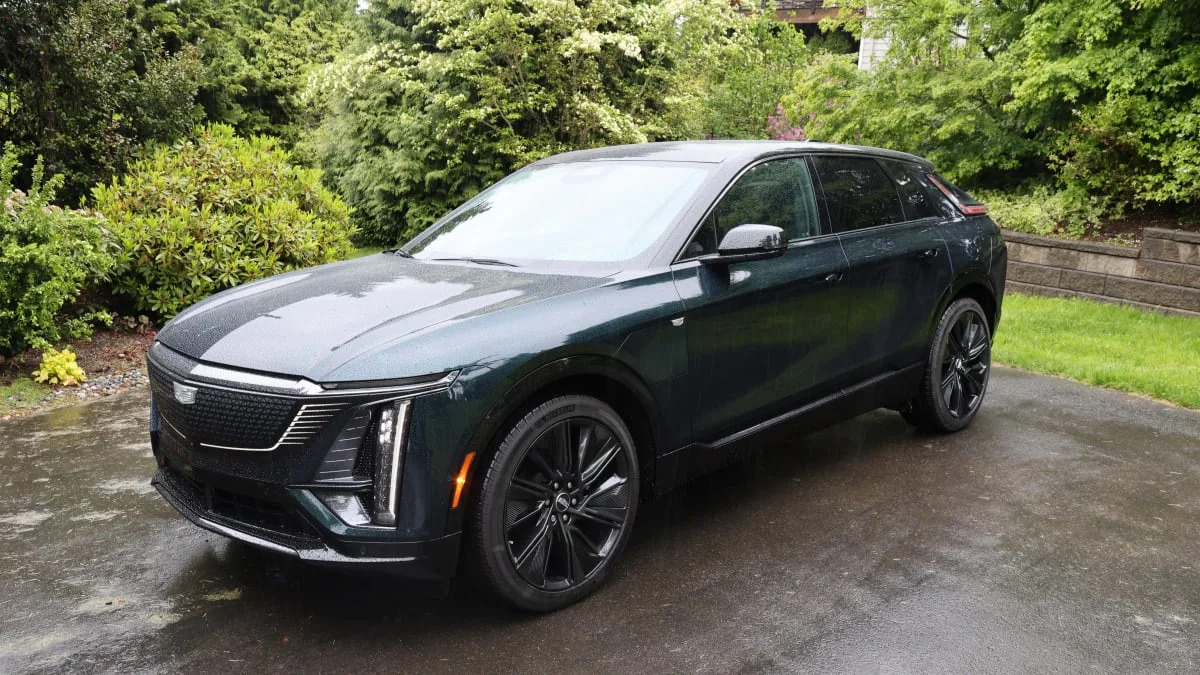
Only in certain light do you get a sense of green; in Seattle overcast, not so much. A few days after the car arrived, I noticed that the Monroney (window sticker) mentioned a contrasting black roof; I hadn’t noticed any difference from the body until then. Later, I encountered a Lyriq of the same color on display in a Costco, and florescent lighting didn’t help any. Peering deep into Emerald Lake Metallic, you get the sense it’s a nice color, with a hint of blue. It would be pretty if they just lightened it up. At least the just-revealed Optiq was shown in a vivid red.
4. The car does the happy dance
The Monroney says the Lyriq is equipped with “LED headlamps and tail lamps with choreography.” These lights do some fancy dancing, though not to a soundtrack like a Tesla, unless I just didn’t figure out how to make music play. As you approach with key fob in pocket, the grille’s Cadillac badge lights up, then various banks of lights front and back swing into action. Rows of LEDs ripple, door handles illuminate, puddle lights glow. It goes on for several seconds and looks like the Tilt-A-Whirl at the fair.
From all this, you get the sense that the car is excited to see you and ready to go for a ride.
5. Speaking of which
In addition to the light show, as you approach the car, the front ends of the flush door handles pop out. “Are those your door handles, or are you just happy to see me” comes to mind. Once you get in and put the car in gear, the handles stow flush again.
A couple of times, the car didn’t detect the fob’s approach, and the handles failed to deploy. They say it happens to the best of us.
6. Show me your badges
As mentioned earlier, the front Cadillac badge lights up. The back one appears to not, but the light-up feature is probably why the car’s badges are drained of the traditional Cadillac crest colors; they’re simply white/translucent, which looks a bit bare. Not sure why a multicolored illuminated badge wouldn’t work just as well.
Fun detail: To open the back hatch, you don’t fumble under the lip of the deck to find the release. You push the badge. Likewise, you push the little badge on the charging door to open that.
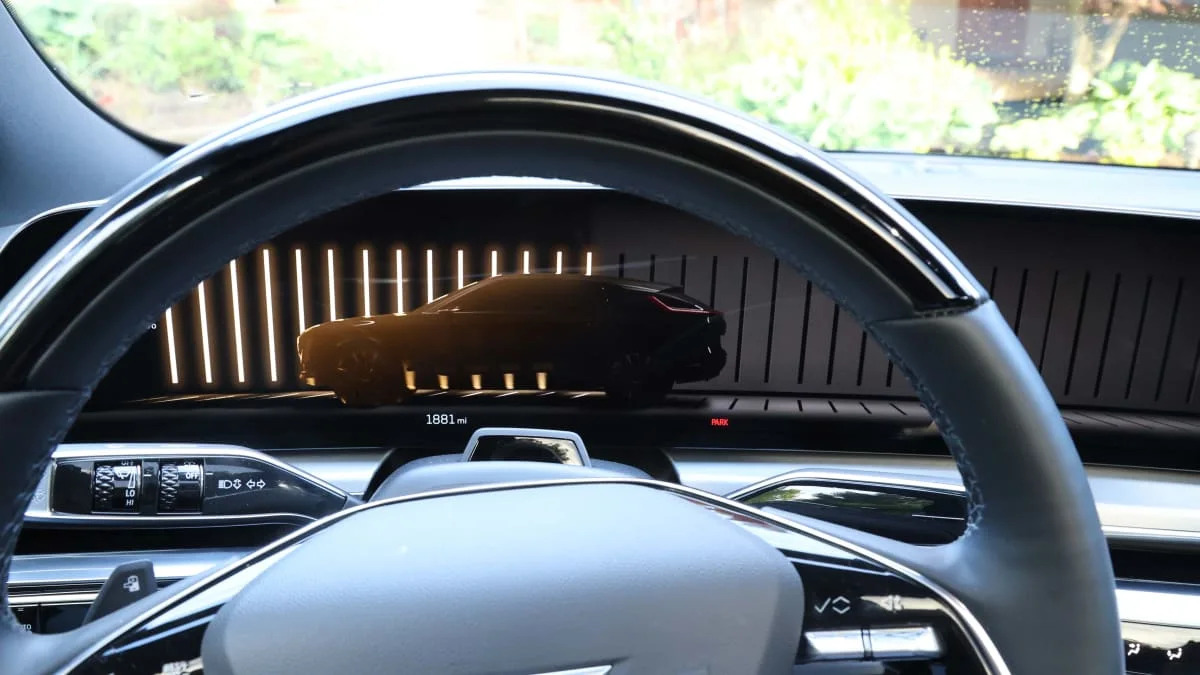
7. Belly up to the bars
Slipping behind the wheel, you’re greeted by another bold design choice: a welcome screen showing the car in profile, backlit by a line of bars showing battery state-of-charge. It spans the whole 33-inch curved screen.
In this display, the car tells you available range in miles — and this seems to be the only place where it tells you percentage of charge remaining. It does this for just a few seconds before disappearing, so you have to catch it before it vanishes. In the early days of EVs, battery percentage was a figure we watched closely; that piece of data seems deprioritized these days.
When the battery is full, all those bars make you feel like you could go anywhere. As they dwindle, it’s time to find a plug.
8. Public charging went well, for a while
The EPA range rating for this two-motor AWD model with big 22-inch wheels is 307 miles. After squandering range on chores around town, I was down to about 180 miles heading off on a highway trip to Bellingham, Wash., 93 miles each way. It was a chance to see how the Lyriq does at a public charger.
The Lyriq’s maximum rate of charge is 190 kilowatts. On the trip’s return leg, a BP charger promised 150 kW. This should be quick. Standing in a puddle in a steady rain next to a big boxful of direct current, I popped the charger into the car, and it quickly spooled up to 138 kW. The Lyriq lapped it up. Those charge bars on the dashboard, by the way, pulsate when the car’s charging, another fun detail.
But suddenly the pulsating stopped — and the charger declared the session ended. Originally it had promised to charge to 100%, but it shut down at 62%. Was that the charger’s fault, or the car’s? No idea. But in a half-hour, I had picked up 130ish miles, which was all I needed. Meanwhile, I had a chance to take a restroom break and explore the infotainment screens. For many reasons, it’s preferable to charge at home, but this highway stop was not time wasted.
While on the subject of electricity, the car consumed it at a rate of 2.4 miles per kilowatt hour, on a trip that was mostly at 70 mph. Not surprising for a 500-horsepower, 5,800-pound luxury car.
9. Super Cruising
Super Cruise worked great, no matter the speed, even in the rain when I dared try that. It handled lane changes flawlessly but performed them a bit quicker than I’d have done myself. It did disconnect a couple of times; better to do that than for the system to proceed in doubt.
Super Cruise is impressive – which is why I never, ever want to own a car with it. It immediately made me a less attentive driver. I was tempted to look at my phone (but didn’t). And I was fiddling with the stereo when someone swung across my lane. The car reacted just fine, but I should have reacted first.
Besides, babysitting technology just isn’t as much fun as being hands-on. These systems might take the tedium out of driving, but they also diminish the joy.
10. The curved dash is cool
The 33-inch curved LED display in the Lyriq and other Cadillacs is responsive and easy to use. On the left is a bank of trip computers and controls for center display choices; on the right is infotainment. Because I have gorilla arms and push the steering wheel all the way in, line-of-sight for some parts of the display was blocked by the wheel; it probably lines up better for most people. Some functions, such as one-pedal driving, are readily accessible onscreen.
Of the instrument panel choices, “Energy’s” readouts are scattered in appearance with a black void mid-screen. “Gauge” is traditionally speedometer-centric; it featured a prominent air quality readout, which seemed like low-priority information (the air quality was just fine) but might be appreciated during Northwest forest fire season. “Clean” is the simplest layout and conveys all you need to know including power consumption info.
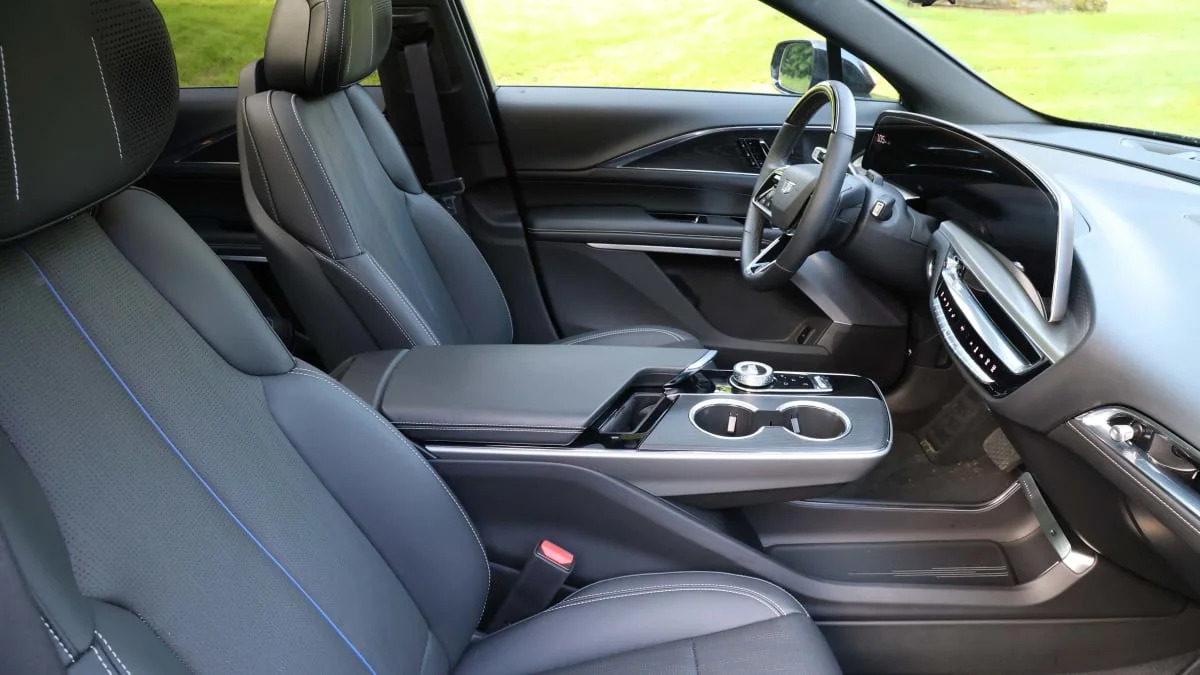
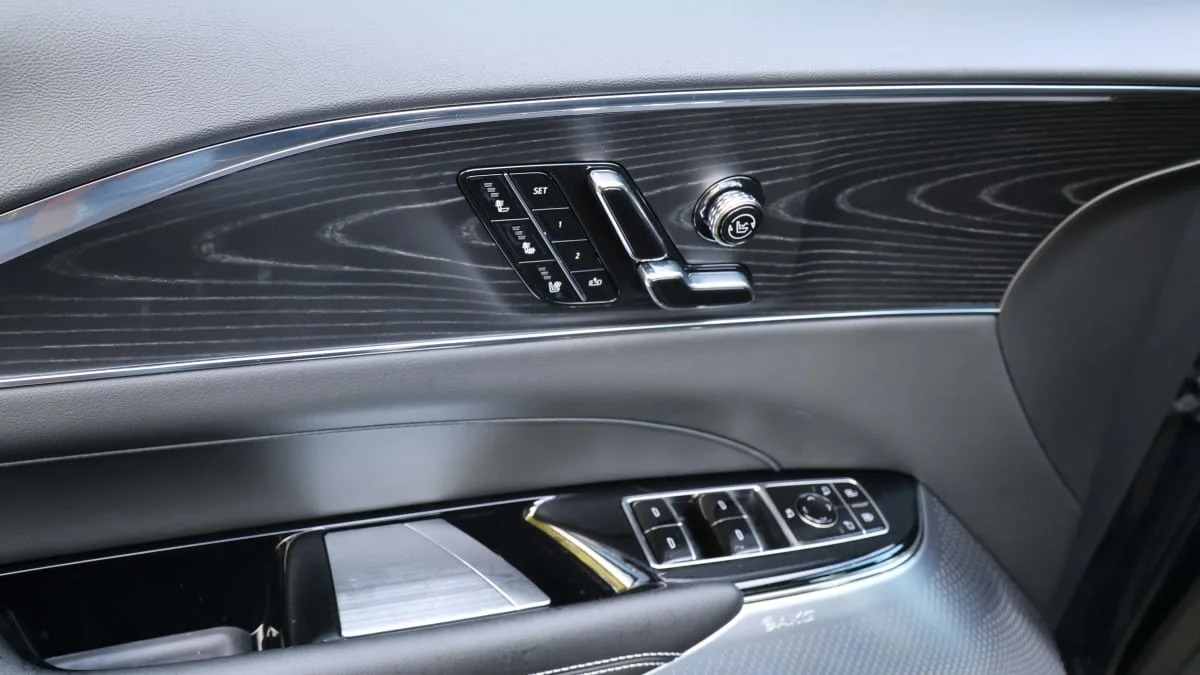
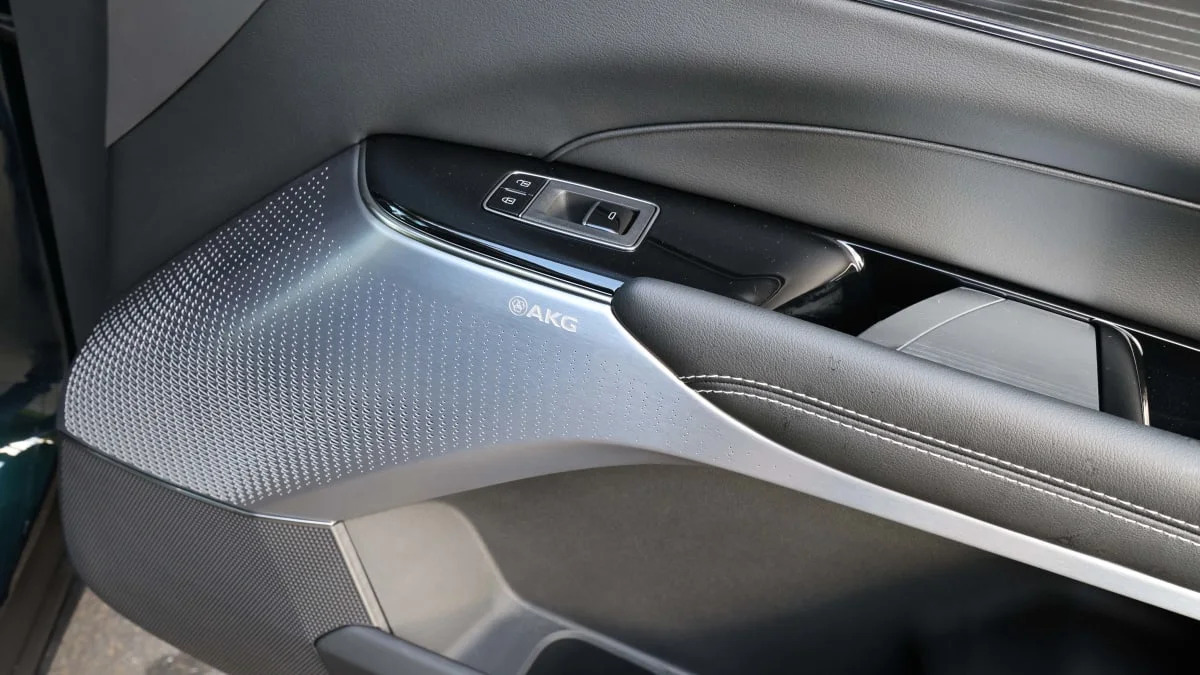
11. Cabin materials
The Lyriq interior’s vibe is solidly luxurious and fits a car costing $77,000 as equipped. It was also distinct in design from a recently driven, also-nice XT4. Cadillac’s littlest SUV has a lot of soft-touch materials — even the inside of the cupholders are padded. The Lyriq goes for a more edgy, metallic, modern look.
The Lyriq’s heated/cooled seats are perforated in a pattern that recalls the Cadillac badge. Metal brightwork abounds; there’s just a bit of black-finish wood on the door panels. The aluminum-clad AKG speaker enclosures are high on the door, so you don’t risk kicking them as you exit. GM channels Mercedes with a shifter stalk on the column and seat controls on the doors. A round knob that toggles lumbar and massage functions was a bit fiddly.
In the XT4, the 33-inch screen is nestled into a dashboard shelf lined with Alcantara, terminating on the right with a Cadillac logo pattern stitched into the material (photo at right above). It’s a unique detail, but the shelf could be a dust magnet. In the Lyriq, that shelf is metallic. There’s blessedly little “piano black,” just on the center console’s infotainment touch panel, and of course it was the only thing in the cabin that looked smudged.
12. Mind your Ps and Qs (purses and quarters)
The curved screen eliminates a center stack, so the footwell is open. On old vehicles, a transmission tunnel separated driver and passenger; in the Lyriq there’s only a low shelf, with a USB-C port indicating it’s for charging a tablet. But a neighbor admiring the car decided it would be a great place to put her purse. Not so sure about that — the rim on this shelf is only about 3-4 inches deep, and it’s easy to imagine certain items toppling over and obstructing the pedals. I noticed a similar shelf in a Tesla Cybertruck recently, and its rim was even shallower.
In the center console, there’s a vertical slot for charging a phone. This too might be an issue. The iconography on this charger says not to let loose change or keys fall into it. The only way that’s not going to happen is if you ban coins from the car altogether.
13. Regeneration: paddle or pedal?
The Lyriq, in addition to brake pedal regeneration, also has a Regen-On-Demand steering wheel paddle (like shifter paddles, but only one, on the left). You can use the paddle to throw out the anchor, creating more regen. You can’t quite fully stop the car with it, though, and a couple times when transitioning to the brake pedal, there was a split-second of electronic confusion before real braking took place. With practice, the best way to use the two forms of regen could probably be mastered. The car also offers one-pedal driving.
14. More scrolling digits, please
There’s a classy little detail in the climate controls, which are all physical switches: When you change the cabin temperature, the numbers don’t just switch, they roll. It’s reminiscent of an old baseball scoreboard, or the big board in an old train station. This was also in the XT4, and it’s a delightful little touch. Wouldn’t it be great if all the displays in this car did that? As the digital speedo changed, the numbers rolled? That could be a distinctive feature, and distinctive is what the Lyriq’s all about.







